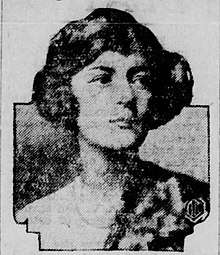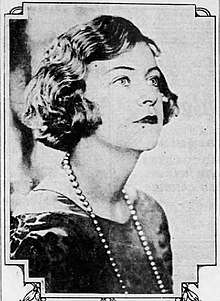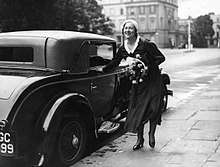Elvira Mullens Barney

Elvira Mullens Barney (22 January 1904 - 25 December 1936) was part of the London society between the world wars and she was charged with killing her lover, Michael Scott Stephen. She was found not guilty but died 4 years later, alone and forgotten, in a Paris hotel room.
Biography
Elvira Mullens was born on 22 January 1904, the daughter of Sir John Ashley Mullens (b. 1870), knight and stock broker, and Evelyne Maude Adamson (b. 1874). Her younger sister, Avril Joy Mullens, married three times: Prince George G. Imeretinsky, Brigadier General Hugh Nugent Leveson-Gower and Ernest Aldrich Simpson.[1][2]
In 1924 she attended the Lady Benson’s Drama Academy. In the same period she was engaged to Charles Patrick Graves.[1]
Middle of the 1920s she had a stint as an actress and appeared as Dolores Ashley in The Blue Kitten at the Gaiety Theatre.[1]
In 1927 she met John Sterling Barney, an American singer, during a party at her parents’ house and they were married on 2 August 1928. The marriage is short lived and already in 1929 John Sterling Barney is back home to America.[1][2]

In 1930 Eliot Hodgkin took the portrait of Elvira Barney.[1]
In 1931 she moved to 21 William Mews, London, for a time living with Henry Mervyn Pearce. In the same period she met Michael Scott Stephen (1908-1932) in Paris and he moved to William Mews later that year.[1]

On 30 May 1932, Barney and Stephen had a dinner party at 21 William Mews; among the guest: Arthur Jeffress, Hugh Armigel Wade, Sylvia Coke, Denys Skeffington Smyth, Brian Howard, Anton Altmann, Irene Mac Brayne, Arthur Streek, Olivia Wyndham and her then girlfriend, Catherine "Ruth" Baldwin (the longtime companion of Joe Carstairs), Edward Gathorne-Hardy.[3] While in London, he lived at 19 Orchard Street, near Selfridges, but often stayed also at the International Sports Club in Upper Grosvenor Street.[4] Barney, Stephen and some of their guests then went to "The Blue Angel", a private club at 52 Dean Street.[4] On the early morning of 31 May 1932, Stephen died of bullet wound and Barney was arrested and charged with murder. At the trial she was defended by Sir Patrick Hastings.[1] He portrayed her as the innocent party and the victim of little value.[5] Hugh Armigel Wade and Arthur Jeffress appeared at the trial. Anton Altmann, Brian Howard, Irene MacBrayne, Sylvia Coke, Denys Skeffington-Smyth, Arthur Streek, Leonie Fester and Terence Skeffington-Smyth, gave police statements. Joe Carstairs sent, through her solicitors, a very forthright letter denying that she was present, even if a Mews' resident testify they had seen her going to buy alcohol with Michael Scott Stephen during the dinner party.[4]
After Hastings' final speech, the Judge Justice Humphreys described it as "certainly one of the finest speeches I have ever heard at the Bar" and Barney was found not guilty both of murder and manslaughter.[6]
The judge was said to have muttered "extraordinary". The press were not sympathetic and they reported that she boasted of killing him at a celebration party following her acquittal.[5]
Barney moved to France and continued her cocaine habit. She was found dead in an hotel room in Paris on 25 December 1936[1] after returning drunk the night before.[5]
References
- 1 2 3 4 5 6 7 8 "Chronology". Cocktails With Elvira. Retrieved 15 January 2018.
- 1 2 "A Princess for the Man who Engineered the Escape of Turkey's Last Sultan - 15 Jul 1934, Sun • Page 13". Detroit Free Press: 13. 1934. Retrieved 15 January 2018.
- ↑ Rose, Andrew (2007). Lethal witness: Sir Bernard Spilsbury honorary Pathologist. Sutton. p. 222. Retrieved 21 January 2018.
- 1 2 3 "30th May 1932 – Parties". Cocktails With Elvira. Retrieved 15 January 2018.
- 1 2 3 Rob Baker (15 November 2015). Beautiful Idiots and Brilliant Lunatics: A Sideways Look at Twentieth-Century London. Amberley Publishing Limited. pp. 85–. ISBN 978-1-4456-5120-0.
- ↑ Peter Cotes, "The Trial of Elvira Barney" (Celebrated Trials Series), David & Charles, 1976, Introduction pp. 20-35.